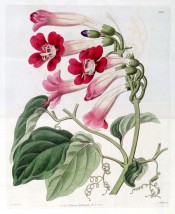Distictis buccinatoria (DC.) A.H.Gentry
A borderline half-hardy vigorous climber with lance-shaped leaflets to 10cm long and racemes of tubular-salverform, purple-red flowers, with yellow towards the bases, particularly noticeable in the bud, from summer to autumn. To 25m. [RHSE, Hortus].
Horticultural & Botanical History
‘For this beautiful species [Bignonia cherere] we are indebted to the Right Honourable the Earl of Grenville, from whose Conservatory at Dropmore it was forwarded by Mr. William Baillie, the Gardener, in July last. It is a native of French Guiana, where it was discovered by Aublet. The natives of that country manufacture the flexible shoots of it and B. incarnata into baskets and broad-brimmed hats, which act as umbrellas, keeping off both the sun and the rain; they use the shoots as cord. […] Willdenow, who had never seen the plant, and who, in fact, knew nothing about it beyond what he had learned from its previous describers, thought proper, in that abominable spirit of change which characterised the school to which he belonged, to alter the name to heterophylla. It is surprising that naturalists cannot see the evil to which these arbitrary and useless interferences with nomenclature give rise.’ [BR f.1301/1829].
‘The name, pronounced Kerere, is that which it is said to bear in Cayenne, whence it comes. I do not know a climbing plant more worthy of cultivation, combining, as it does, a remarkably fine, deep-green foliage with beautiful flower buds and rich glowing flowers. It is difficult to keep it within bounds and it is to be regretted that so beautiful a climber is not more generally grown. What a boon would a free-flowering yellow species be.’ [Gard. Chron 1851].
According to Johnson’s Dictionary, Bignonia chirere was first cultivated in Europe in 1824. FC p.49/1836.
History at Camden Park
Listed only in the 1850 and 1857 catalogues [T.156/1850] it was probably obtained from Loddiges’ nursery. It was included among desiderata in a letter dated 16th April 1846 [MP A2933-1, p.147].
Notes
Bignonia cherere Aubl. is considered by some authors to be a different, but similar species, with smaller, yellow flowers. [BM t.7516/1897].
Published Feb 25, 2010 - 02:22 PM | Last updated Jul 15, 2010 - 10:42 AM
| Family | Bignoniaceae |
|---|---|
| Category | |
| Region of origin | Central and South America |
| Synonyms |
|
| Common Name | |
| Name in the Camden Park Record |
Bignonia cherere |
| Confidence level | high |


